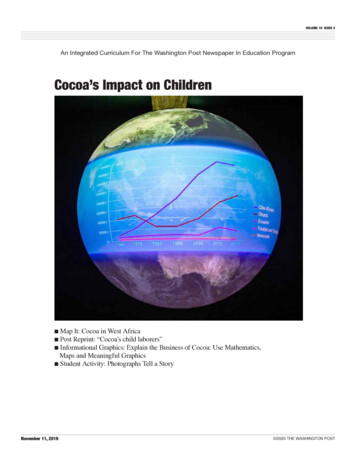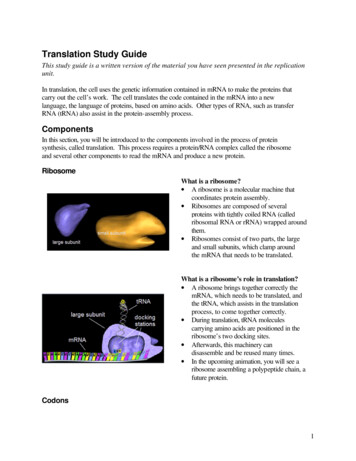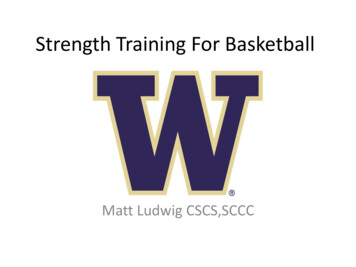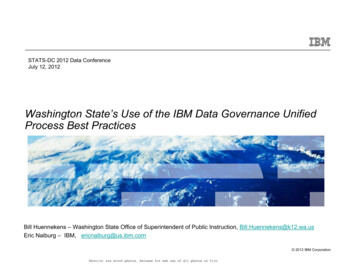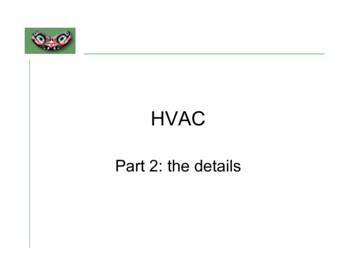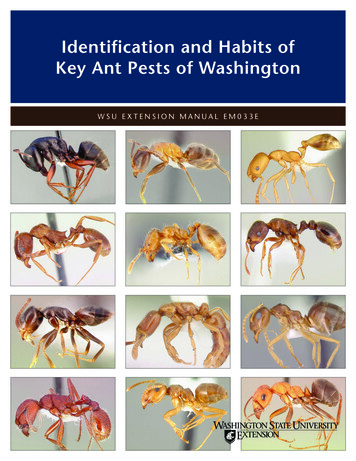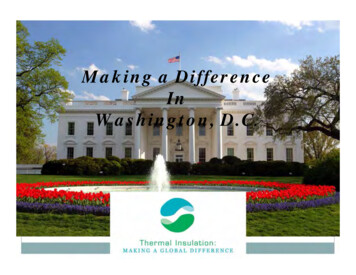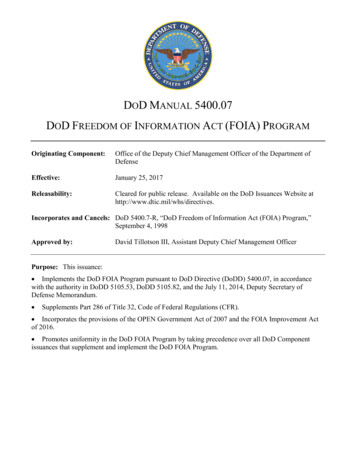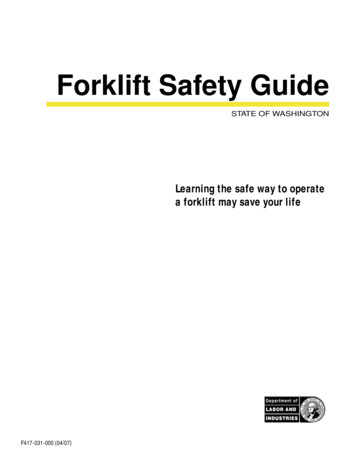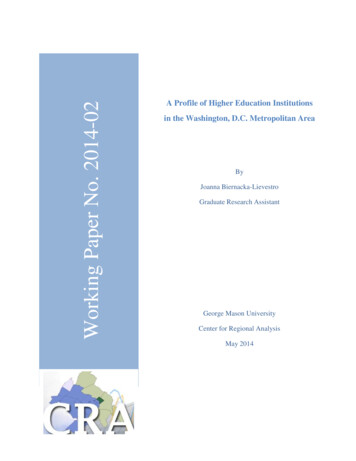
Transcription
Working Paper No. 2014-02A Profile of Higher Education Institutionsin the Washington, D.C. Metropolitan AreaByJoanna Biernacka-LievestroGraduate Research AssistantGeorge Mason UniversityCenter for Regional AnalysisMay 2014
A Profile of Higher Education Institutionsin the Washington, D.C. Metropolitan AreaWorking Paper 2014-02byJoanna Biernacka-LievestroGraduate Research AssistantIntroductionThe Washington, D.C. metropolitan area is one of the leading hubs for higher education in theUnited States. A 2012 study by the Martin Property Institute,1 which analyzed the CensusBureau’s 2010 American Community Survey data, places metropolitan Washington, D.C. as thefourth largest college town in the United States, following only New York City, Los Angeles andChicago. The Washington, D.C. region surpassed other metropolitan areas with highconcentrations of college students, such as Philadelphia, Boston, Dallas-Fort Worth, Miami, SanFrancisco and Atlanta.This research shows that there are at least 93 institutions of higher education operating in theWashington, D.C. metropolitan area. This report presents data on these institutions’enrollment and employment by type and location. Due to reporting limitations, data were onlyavailable for 78 of these institutions.As of the Fall 2012 semester, the 78 analyzed universities and colleges enrolled approximately338,000 graduate and undergraduate students and employed about 70,600 faculty and staff. Itmust be emphasized that the numbers of students and employees are underestimated due tomissing data for the 15 schools and because it is expected that the list of public and privateuniversities and colleges compiled for this research is not exhaustive.21Florida Richard. America’s Leading College Towns. The Atlantic CityLab. August 27, s-leading-college-towns/3054/.2The list of universities and colleges used in this study was compiled based on higher education consortia andinternet research. It is expected that more schools operated in the region during the Fall 2012 semester.1
Distribution of the Institutions, Students and Employeesin the Washington RegionIn Fall 2012, the region’s 93 institutions included 48 local colleges and universities, campuses of22 institutions headquartered outside of the metropolitan region operating year-round, and 23non-local institutions offering semester-long academic and/or internship programs in theregion (Appendix Tables 1 through 3). Among the 78 schools that reported their data, 16 arereligious-affiliated, three are military universities, two specialize in art and design degrees,three specialize in technical degrees, and seven specialize in health-care degrees.The Washington region’s close proximity to the Federal government and think-tanks is a keyasset for many of these institutions, particularly non-local universities that offer internshipprograms for students studying outside of the region. The region also hosts several campusesof schools with remote headquarters. Most of these facilities are concentrated in the District ofColumbia; surrounding jurisdictions predominantly accommodate local institutions. While databy institution for the whole metropolitan region are reported (as presented in the Appendix),the numbers broken down by jurisdiction are limited. Table 1 presents the available data onstudent enrollment and employment by jurisdiction. The unreported students and employeeswere located outside of the District of Columbia, but it is not known in which jurisdictions.Table 1Student Enrollment and Employment in Higher Education Institutions by Jurisdiction, Fall 2012Washington, D.C.Prince George’s CountyFairfax CountyMontgomery CountyArlington CountyAlexandria CityPrince William CountyFrederick CountyLoudoun CountyManassas CityFredericksburg 13.987001.063890.599231.3966,307100%No. ofCampuses411014513553311101Note: Included are 78 institutions that in total have 101 campuses in the region. Excluded are 15 institutions withunavailable data.*Includes full-time and part-time students.** The numbers of employees are underestimated due to the missing data for employment in several institutions.2
3
The bulk of enrollment and employment is concentrated in the region’s 10 largest institutions.3These institutions, which are all locally based, account for 79.53 percent of all the students and78.11 percent of faculty and staff. The remaining 38 local institutions make up 16.32 percent ofall students and 18.56 percent of employees. The institutions headquartered outside of theregion contribute only 4.13 percent of students and 1.87 percent of employees. However, theirimpacts on the region’s economy are amplified, as nearly all of these students and employeeswould not have otherwise been in the region.3The ten largest institutions include: Northern Virginia Community College, University of Maryland UniversityCollege, University of Maryland College Park, Montgomery College, Goerge Mason University, George WashingtonUniversity, Georgetown University, Prince George’s Community College, American University and HowardUniversity.4
ConclusionInstitutions of higher education supported more than 338,032 full-time and part-time studentsand 70,635 employees in the Washington, D.C. metropolitan area as of the Fall 2012 semester.While these numbers are underestimated due to data limitations, even these estimatesdemonstrate the value of higher education to the regional economy and employment base.The students, faculty, and administrative employees generate economic activity through theregion and enhance its human capital – a crucial component of healthy economy. Theuniversities and colleges tend to “have significant purchasing power, attract substantialrevenues for their surrounding economies, invest heavily in local real estate and infrastructure,are major employers, and help to train the workforce and nurture new business.”4 Although it isnot commonly recognized, metropolitan Washington, D.C. is one of the leading college townsthe United States. The impact of higher education on the regional economy is likely significant,but understudied.4Economy League. Leveraging Colleges and Universities for Urban Economic Revitalization. Greater PhiladelphiaRegional Review. Spring 2003. ging.pdf.5
Notes on DataThe sources used to compile the list of higher education institutions operating in Fall 2012 inthe Washington, D.C. metropolitan area include: Consortium of Universities of the WashingtonMetropolitan Area, Virginia Tidewater Consortium for Higher Education, National Center forEducation Statistics, College Board, Yahoo! Local (Colleges and Universities) and internetresearch. It is expected that the list is not exhaustive and there were more colleges anduniversities operating in the region.The data presented in this report come from the institutions’ official reports and fact sheets,from the National Center for Education Statistics, from the Opening Fall Enrollment Report bythe Maryland Higher Education Commission5, and from interviews with the institutions’registrar and human resources offices as well as semester program coordinators. The numbersare approximations, as institutions may differ in how they report the student and employeecounts. Often, data broken down by location are unavailable so the totals may under- or overestimate the real numbers.5Maryland Higher Education Commission. Opening Fall Enrollment Report. MHEC: December 2012.6
AppendixTable 1Higher Education Institutions with Local Headquartersin the Washington D.C. Metropolitan AreaFall 2012 4.15.16.17.18.19.20.21.22.23.Northern Virginia Community CollegeUniversity of Maryland University CollegeUniversity of Maryland College ParkMontgomery CollegeGeorge Mason UniversityGeorge Washington UniversityGeorgetown UniversityPrince George's Community CollegeAmerican UniversityHoward UniversityCatholic University of AmericaFrederick Community CollegeBowie State UniversityUniversity of the District of ColumbiaUniversity of Mary WashingtonMarymount UniversityTrinity Washington UniversityHood CollegeMount St Mary’s UniversityStratford UniversityGallaudet UniversityWashington Adventist UniversityUniformed Services University of HealthSciencesSchool 415343076563421,0072491,087Page 7
nal Defense UniversityPublic1,20601,206348Virginia TechPublic1,14081,132205University of Management and TechnologyPrivate1,061790271164Capitol CollegePrivate905441464124National Intelligence UniversityPublic7159861786Corcoran College of Art and DesignPrivate634386248351Wesley Theological SeminaryPrivate6340634112National Labor CollegePrivate6186180101Maryland University of Integrative HealthPrivate5115110131Columbia CollegePrivate419419090University of the PotomacPrivate3113110103Global Health CollegePrivate265265037Virginia Theological SeminaryPrivate2270227174Institute of World PoliticsPrivate138013878Pontifical Faculty of the Immaculate Conception Private011758at the Dominican House of Studies11739. Pontifical John Paul II Institute for Studies onPrivate103010321Marriage and Family40. Maple Springs Baptist Bible College andPrivate99742538Seminary41. Institute for the Psychological SciencesPrivate840843742. Notre Dame Graduate School of ChristendomPrivate8408414College43. Washington Theological Note: Other institutions with local headquarters that operated in the Washington metropolitan area during the Fall 2012 semester include:Washington Baptist University, William Samson University, and American Open University. Data for these institutions are unavailable at the timeof writing this report.*Includes full-time and part-time students.Page 8
Table 2Higher Education Institutions with Remote Headquartersin the Washington D.C. Metropolitan AreaFall 2012 utionSchool 6601,3271, e3,757746253000927220005890297Johns Hopkins UniversityPrivateu/k**MarylandDeVry UniversityPrivateu/k**IllinoisUniversity of PhoenixPrivate360ArizonaThe Art Institute of WashingtonPrivate350Multiple locationsITT Technical InstitutePrivate94IndianaMedtech CollegePrivate89Multiple locationsArgosy UniversityPrivate343CaliforniaAverett CollegePrivate338VirginiaWestwood CollegePrivate177Multiple locationsSanford-Brown CollegePrivate106Multiple locationsEverest CollegePrivate122Multiple locationsWebster UniversityPrivate77MissouriChamberlain College of NursingPrivate59Multiple locationsThe Chicago School of ProfessionalPrivate28IllinoisPsychology15. University of CaliforniaPrivate270270036California16. Park 32,8342,204***Note: Other institutions with remote headquarters that operated in the Washington metropolitan area during the Fall 2012 semester include:University of Virginia, Strayer University, Stevens Institute of Technology, Central Michigan University, Lancaster Bible College and BostonUniversity. Data for these institutions are unavailable at the time of writing this report.*Includes full-time and part-time students.**u/k unknown; data on the number of employees are unavailable for Johns Hopkins University and DeVry University.***The total number of employees is an underestimation due to the missing data for employment at Johns Hopkins University and DeVryUniversity.Page 9
Table 3Institutions Offering Semester-Long Academic and Internship Programsin Washington D.C. Metropolitan AreaFall 2012 SemesterNo.1.2.3.InstitutionSchool sHeadquartersGraduate000Lewis & Clark CollegePrivate4OregonCornell UniversityPrivate18New YorkLutheran College WashingtonPrivate9Multiple locationsSemester4.University of TexasPublic333307Texas5.Carnegie Mellon University HeinzPrivate2402417PennsylvaniaCollege6.Penn StatePublic202005Pennsylvania7.University of PittsburghPublic200203Pennsylvania8.Grinnell CollegePrivate191902Iowa9.University of MichiganPublic191906Michigan10. University of GeorgiaPublic161602Georgia11. Claremont McKenna CollegePrivate161604California12. Hamilton CollegePrivate161601New York13. James Madison UniversityPublic121201Virginia14. University of PennsylvaniaPublic121205Pennsylvania15. Ohio State UniversityPublic121205Ohio16. College of William and MaryPublic101007Virginia17. Pepperdine UniversityPrivate9902California18. Hillsdale CollegePrivate6604Oklahoma19. Centre CollegePrivate3302KentuckyTotal36331944104Note: Other institutions offering semester-long academic and/or internship rograms that operated in the Washington metropolitan area duringthe Fall 2012 semester include: Stanford University, Stonehill College, Syracuse University and Washington University in St. Louis. Data for theseinstitutions are unavailable at the time of writing this report.*Includes full-time and part-time students.Page 10
8. Averett College Private 914 892 22 338 Virginia 9. Westwood College Private 907 907 0 177 Multiple locations 10. Sanford-Brown College Private 733 733 0 106 Multiple locations 11. Everest College Private 649 649 0 122 Multiple locations 12. Webster University Private 589 0 589 77 Missouri 13.
